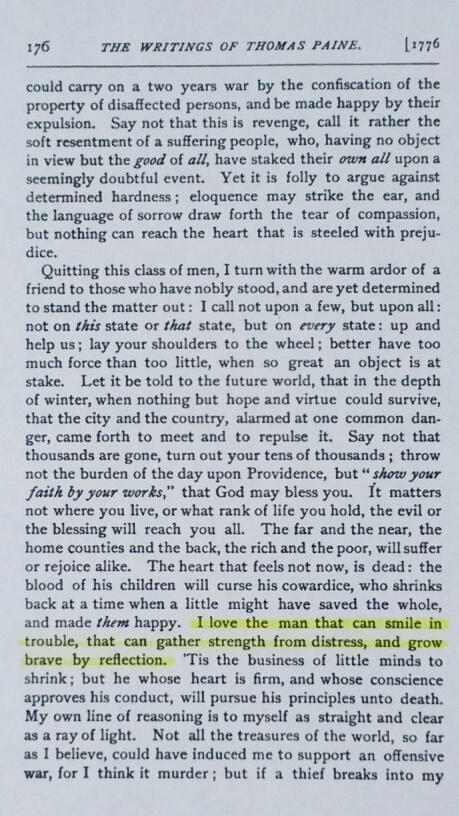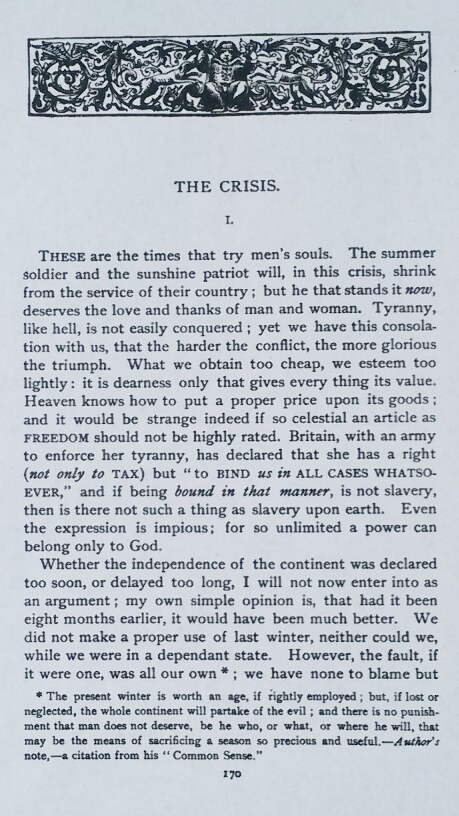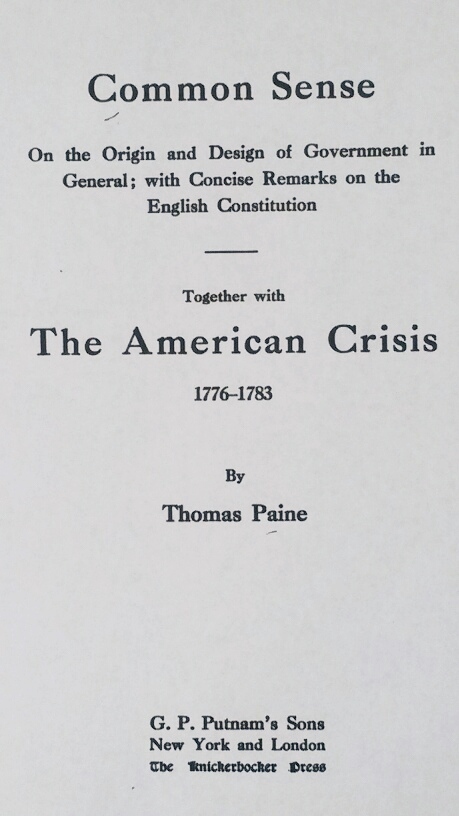Today’s post is about a wildly popular inspirational quote that is often misworded and misattributed to Leonardo da Vinci. Follow along to learn who really wrote it as well as who is spreading this misinformation across the internet.
The Misattributed and Misworded Quote Variations
✘“I love those who can smile in trouble, who can gather strength from distress, and grow brave by reflection.”
Leonardo da Vinci
✘“I love those who can smile in trouble, who can gather strength from distress, and grow brave by reflection.”
Thomas Paine
✘“The real man smiles in trouble, gathers strength from distress, and grows brave by reflection.”
Thomas Paine
✘“I love the man that can smile at trouble; that can gather strength from distress, and grow brave by reflection.”
Thomas Paine
The Correct Quote
✓“I love the man that can smile in trouble, that can gather strength from distress, and grow brave by reflection.”
Thomas Paine
The American Crisis, No. I
December 1776
The American Crisis is a series of 16 essays by Thomas Paine published from 1776–1783 under the pseudonym Common Sense. Thirteen of the essays are numbered, and the quote appears in essay number 1.
Here is the quote found on page 176 in G. P. Putnam’s Sons 1912 publication of Common Sense Together with The American Crisis.
Here is the beginning of essay number 1 on page 170. Note the famous first sentence.
Here is the title page of the publication.
The Library of Congress has a copy of the original pamphlet published in Boston titled “The American Crisis (No. 1).” The quote appears in the third column at the end of the 23rd line (which begins with “might have saved”).
If this link does not work, you can find the document by following these steps:
1. Go to the Library of Congress website (www.loc.gov)
2. Enter “The American Crisis (No. 1)” in the search bar
3. Click on the link to the document
4. Click on the document image
5. Click the “+” button to zoom in for better viewing
This Misquote Is Often Cited As Two Sentences
In the above-referenced copy of the original pamphlet, the wording and punctuation of the quote and the subsequent sentence are as follows:
“I love the man that can smile in trouble, that can gather strength from distress, and grow brave by reflection. ‘Tis the business of little minds to shrink; but he whose heart is firm, and whose conscience approves his conduct, will pursue his principles unto death.”
Compare this correct version to the most popular misattributed versions (I have underlined the incorrect wording and punctuation):
“I love those who can smile in trouble, who can gather strength from distress, and grow brave by reflection.”
“I love those who can smile in trouble, who can gather strength from distress, and grow brave by reflection. ‘Tis the business of little minds to shrink, but they whose heart is firm, and whose conscience approves their conduct, will pursue their principles unto death.”
The Most Popular Versions Are Not Only Misattributed but Are Misworded
The comparisons above demonstrate that the most popular versions of this misquote are misattributed AND misworded. Some may think slight rewording or paraphrasing is acceptable; however, I absolutely object to that when it comes to important historical documents such as The American Crisis. It is a shame that it is Americans, for the most part, who are attributing this quote to someone other than Thomas Paine. Rewriting the words just adds insult to injury.
Statistics
After surveying 150 websites featuring today’s misquote, I found the following trends.
Percentage Type of Website
35% Quotes only
27% Social media
14% Informational
8% Corporation/Corporate Individual
7% Quotes a major feature
5% Online app or service
2% Topical group or discussion forum
1% Quotes paraphernalia for purchase
1% Organization
Quote Websites Are the Main Source of Today’s Misquote
Based on the above statistics, the main source of today’s misquote are websites that specialize solely in providing quotes. The 7% of websites that provide quotes as a major feature of their functionality should also be noted. These two categories together mean 42% of the sites featuring this misquote are major databases specializing in quotes. This is a classic example of what’s known in computer science as GIGO (garbage in, garbage out). In other words, if the quality of the input is garbage, the quality of the output is garbage. And for some reason, the vast majority of websites that specialize in quotes have no quality control whatsoever. In fact, many of them allow any user to add any data at any time. In a nutshell, these websites should be avoided at all costs.
Social Media Is Another Source of Today’s Misquote
The above statistics also show that social media is the second major source of propagation for today’s misquote. As I’ve mentioned in previous posts, the quote virus quickly and easily spreads its germs through social media. Every user that posts a misquote spreads it to all of his/her followers, who spread it to all of their followers, who spread it to all of their followers, etc. The bottom line is never trust a quote sent to you via social media. There’s a high probability it is infected.
We May Have an Incubating Mutant
During my research, I came across an Instagram post featuring the misquote attributed to Thomas Paine. I then noticed underneath it another user posted the comment, “I think that’s a Da Vinci or DiCaprio quote.” Knowing how social media works, I wouldn’t be surprised if a new mutation emerges in the near future attributing the misquote to Leonardo DiCaprio. Stay tuned.
Most Amusing Finds
My most amusing find is a Leonardo da Vinci website that features today’s misquote. The sole purpose of this website is to provide information about Leonardo da Vinci and only Leonardo da Vinci. One would think with a subject-matter scope this narrow all data provided would be verified. Unfortunately, this bit of misinformation makes all information on the website suspect.
My second amusing find is a book of Leonardo da Vinci quotes published in 2013, and you guessed it; our misquote is proudly featured in the book. One has to wonder why anyone would go through all the effort to publish a book and not fact-check any of the data. The end result is a book that has no credibility, and the author becomes another carrier in today’s misinformation epidemic. Unfortunately, the advent of quick and easy self-publishing has contributed heavily to this modern-day plague.
Most Disappointing Finds
I was very disappointed to see today’s misquote featured as the “Quote of the Week” on a blog written by K-12 principals and school administrators. One would think educators would be a little more diligent about the information they are conveying.
I was also disappointed to find a scrapbooking website based in Ohio that features today’s misquote on a list of suggested quotes to use. Not only is the quote misworded, but it is attributed to Thomas Payne instead of Paine. It is sad that the name of a well-known, important historical figure in American history is misspelled, and no one has noticed or bothered to correct it since 2013 when the site was established.
Quote Books Often Feature Misquotes
I came across seven quote books featuring today’s misquote. The publication dates range from 2003 to 2015. Unfortunately, most modern quote books are merely compilations of quotes obtained from the internet and other previously published quote books. If there is no accompanying detailed source information with each quote, the book should not be trusted. Citing the writer/orator’s name alone is not sufficient. The source information should include the name of the work in which the quote is found followed by applicable information such as chapter, act, scene, stanza, line, etc.
Misquotes Can Be Found in a Wide Variety of Books
I also found today’s misquote in 11 books that are not specifically about quotes. The publication dates range from 2007 to 2015, and the topics vary from fiction to spirituality to stress management to water-and-waste management.
Misquotes for Sale
As always, I found our misquote available for purchase. For $15.95 you can have your own misquote coffee mug. If you prefer something a little more artsy, a canvas misquote poster can be yours for just $59.00. It’s amazing how many flawed merchandise options there are!
Let’s Kill the Quote Virus
The quote virus can only be killed through education and safe quoting. You can help by sharing the knowledge with your family and friends. Also, if you’re on Facebook, you can “like” my Facebook fan page, and if you’re on Twitter, you can follow me @SueBrewton.
Finally, remember to practice safe quoting by never trusting quotes on quote websites or social media. Also be wary of quote books that don’t have detailed source information. Until next time,
“Be the antidote and don’t misquote.”
©Sue Brewton



Great article, I agree that misworded quotes are unacceptable and it is a shame that our literary history is being rewritten by the quote virus. Thanks for bringing this important issue to light.